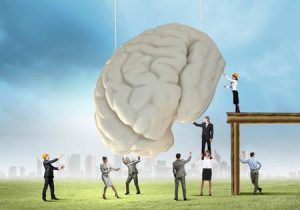Home » About Mindbugs »
More and better international brain research answers the question: How does our brain work? These studies show that the decisions our brains make are often much less rational than we think. In many of our decisions, our subconscious is leading, without us knowing or even wanting to.
We used to know very little about our brain and exactly how it worked. Scientists had assumptions, but we were not sure. But today we can see through electrodes and scans which part of the brain becomes active in humans at what time, and we learn a lot about how the brain works.
How our brains work?
Although your brain is only two percent of your total weight, it uses twenty percent of the total blood flow and in  ratio ten times as much oxygen as other organs in your body. Your brain, along with your spinal cord and nerves, form the nervous system that is connected by some one hundred billion nerve cells called neurons that exchange information.
ratio ten times as much oxygen as other organs in your body. Your brain, along with your spinal cord and nerves, form the nervous system that is connected by some one hundred billion nerve cells called neurons that exchange information.
This way your brain continuously knows exactly what is happening in and around your body. Some things automatically regulate your nervous system and your body (for example, your breathing and your blood pressure). For other things your conscious perception and control is needed. All information comes in through your senses: everything you hear, see, smell, feel and taste is passed on through your nervous system. Your eye is dominant: 70 percent of all sensory information comes in through your eyes. You only need a tenth of a second to “capture” an image.
All nerve cells are connected to each other, often via several connections. Nerve cells receive a stimulus and each cell “determines” itself whether it passes on the stimulus. In this way, your cells (and therefore you) make decisions. Of the countless decisions you make in a day, a large part, about 90 percent, is unconscious. You do act on the decision, but you haven’t really thought about it actively.
Quick decision maker
The world around us is incredibly complex. All our senses are continuously stimulated. Just be aware of what you are feeling, hearing, tasting or smelling as you read this. Do you notice how much is happening around you that you only noticed when you consciously paid attention to it?
Our brain has the task of bringing peace and clarity to that abundance of observations. It ensures that as you read this book, you can concentrate on the text and that you are not distracted by all those other stimuli in your environment. Very handy. But there is also a downside to it. Because our brain “selects” to create that peace and overview, we sometimes do not see what is actually happening, but we see the interpretation of it. We perceive the world as what our brain makes of it. Not like the way the world really is.
Our unconscious decisions, all day long, affect our behavior much more than we think. That starts very early. From the moment we are born we look at other people and try to label them to make it easier on our brains. We also constantly learn from an early age from the people around us – from the people who are like ourselves. It is simply impossible not to be influenced by the people around you, the culture and the society in which you grow up. The ideas, views, norms and values of our environment make a deep-rooted impression. (Jack Canfield, author of the book Chicken Soup for the Soul even writes, “We are the product of the five people we associate with the most.”) Their views are taking root in our subconscious.
We are constantly labeling and categorizing our environment based on all those ideas, beliefs and values. That is a survival strategy of our brain. And at any time of the day we are surrounded by information – sounds, images, smells, facts, events and feelings. It would be impossible to constantly consider every piece of information in everything we do or every decision we make. And we don’t. We constantly rely on assumptions and expectations that set the automatic part of our brain in motion.
Our brains block more diversity
Managers are open to diversity. They also see women as equally competent leaders as men. And of course, managers do everything they can to select the best people for their teams. Why shouldn’t they? They want the best people for the best results. That is their importance. And that is often precisely why they resist policies that “require” them to be more diverse in their own teams. They now choose the (in their eyes) best candidates, and if they have to hire other people for more diversity, they see that as a step backwards. “Are you really saying that we should appoint other people for more diversity? We just want to keep choosing the best, “is often the first response of managers when an organization takes such measures. That reaction makes perfect sense. But there is a catch in it. As managers, we all want to pick the best and we think we do – but we can’t. Not just. And important to remember: if we really chose the very best, teams would automatically be much more diverse.
On this website, we also show you why this is so important for understanding diversity. And we will also show you how large organizations like Philips, EY, ABN AMRO but also the Utrecht University, NWO, Municipal Enschede and MN Services have already based important diversity policy on this.
All in the same boat
Everyone – you, me, the CEO and the intern – has beliefs and therefore certain unconscious prejudices about others. They are often positive about people who look like us and who are part of our so-called ‘inner group’. Often more negative about the people in the “outer group”. We have those judgments and beliefs about others, but also about groups to which we belong ourselves. Now if you think “well, I don’t actually have that at all”? Then I can reveal to you unseen: yes. Because there is really no one in the world who does not have these kinds of unconscious judgments. It is not intent or unwillingness. It is our brain that makes connections without being asked. What does all this mean for diversity? A lot of. Getting to understand your brain better is an important ingredient in building diverse teams. To begin with, our brain makes us prefer people who are like us. That affects how we assess people and choose our teams. It may go against all of our firm beliefs, but it turns out time and again that we don’t necessarily choose “the best people.” Despite our conscious intentions, despite our conscious desire to really choose the best candidates. We unconsciously choose “people who are like us”. This may not be what we really want, but it is what we do. Wherever in the world this is researched, in all cultures, at all ages, people have an unconscious preference for people who “look like us.”
“It all starts with recognizing and acknowledging our unconscious biases”
Esther Mollema
Want to know more?
Do you also want to know whether you and your colleagues are “bothered” by Mindbugs?
Contact us today





















